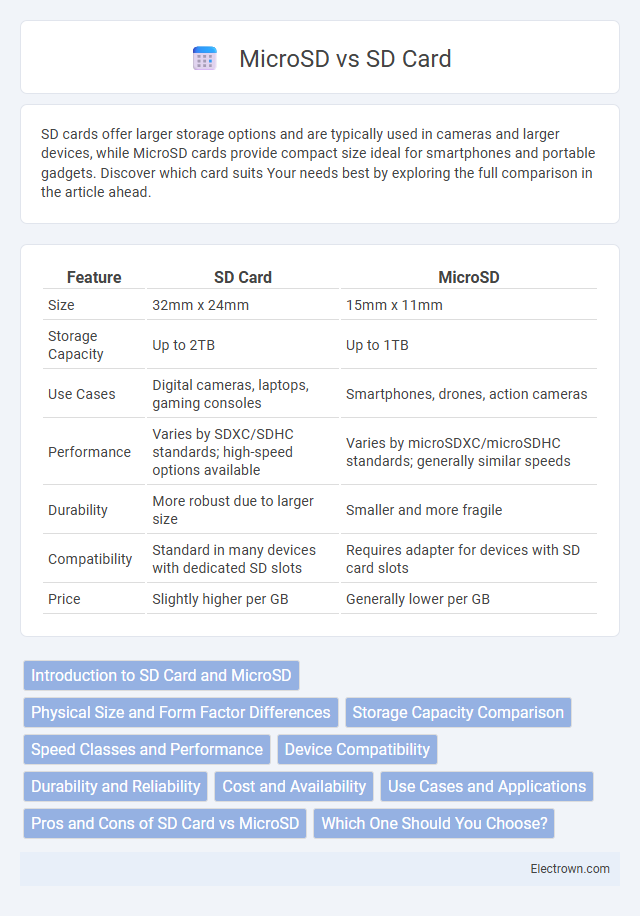SD cards offer larger storage options and are typically used in cameras and larger devices, while MicroSD cards provide compact size ideal for smartphones and portable gadgets. Discover which card suits Your needs best by exploring the full comparison in the article ahead.
Table of Comparison
| Feature | SD Card | MicroSD |
|---|---|---|
| Size | 32mm x 24mm | 15mm x 11mm |
| Storage Capacity | Up to 2TB | Up to 1TB |
| Use Cases | Digital cameras, laptops, gaming consoles | Smartphones, drones, action cameras |
| Performance | Varies by SDXC/SDHC standards; high-speed options available | Varies by microSDXC/microSDHC standards; generally similar speeds |
| Durability | More robust due to larger size | Smaller and more fragile |
| Compatibility | Standard in many devices with dedicated SD slots | Requires adapter for devices with SD card slots |
| Price | Slightly higher per GB | Generally lower per GB |
Introduction to SD Card and MicroSD
SD Cards and MicroSD cards are widely used storage devices designed to expand memory capacity in various electronic devices. SD Cards are larger, typically measuring 32mm x 24mm, and are commonly used in cameras, laptops, and other portable devices. MicroSD cards, much smaller at 15mm x 11mm, provide the same functionality but are optimized for smartphones, tablets, and compact gadgets, offering versatile options to fit your storage needs.
Physical Size and Form Factor Differences
SD cards measure 32mm x 24mm x 2.1mm, making them significantly larger than microSD cards, which are only 15mm x 11mm x 1mm. The larger form factor of SD cards allows for easier handling and compatibility with full-sized SD card slots commonly found in cameras and laptops. MicroSD cards are designed for compact devices like smartphones and tablets, fitting into much smaller slots to support slim, portable electronics.
Storage Capacity Comparison
MicroSD cards generally offer storage capacities ranging from 2GB to 1TB, making them much smaller but equally powerful compared to standard SD cards, which typically range between 4GB and 512GB. Your choice depends on device compatibility and storage needs, with MicroSD cards favored for compact devices like smartphones and drones due to their high capacity in a tiny form factor. Storage capacity directly influences data management efficiency, so selecting the right card ensures optimal use of your available space.
Speed Classes and Performance
SD Cards and MicroSD cards offer different speed classes, such as Class 10, UHS-I, UHS-II, and V30, which directly impact performance in data transfer and video recording. MicroSD cards often match SD card speed ratings but may vary in sustained write speeds due to size and application constraints. Your choice should consider the specific speed class required for smooth 4K video capture or rapid file transfers to maximize device compatibility and efficiency.
Device Compatibility
SD cards are widely compatible with cameras, laptops, and some tablets, whereas MicroSD cards are primarily used in smartphones, action cameras, and drones due to their compact size. Many devices support both formats through adapters, allowing you to use a MicroSD card in an SD card slot, enhancing versatility. When choosing between SD and MicroSD cards, consider your device's specific slot type to ensure seamless compatibility and optimal performance.
Durability and Reliability
MicroSD cards typically offer enhanced durability due to their smaller size and robust design, making them more resistant to physical damage such as bending or breaking compared to standard SD cards. Both SD and MicroSD cards use similar NAND flash memory technology, but MicroSD cards are often rated for higher shock, temperature, and water resistance, which contributes to their reliability in harsh environments. Manufacturers like SanDisk and Samsung provide extended durability warranties on MicroSD cards, emphasizing their reliability for portable devices and long-term data storage.
Cost and Availability
MicroSD cards generally cost less than full-sized SD cards due to their smaller size and widespread use in mobile devices, making them a more budget-friendly option for storage upgrades. Both SD and MicroSD cards are widely available in various storage capacities, but MicroSD cards are often more prevalent in retail outlets and online stores, enhancing accessibility for your needs. Choosing between the two depends on your device compatibility and whether cost or convenience is your priority.
Use Cases and Applications
SD cards are commonly used in digital cameras, camcorders, and laptops due to their larger physical size and easier handling. MicroSD cards excel in mobile devices like smartphones, drones, and action cameras where compact storage solutions are essential. Both card types support high-capacity storage and fast data transfer speeds, making them versatile for various multimedia and professional applications.
Pros and Cons of SD Card vs MicroSD
SD cards offer faster data transfer speeds and greater durability, making them ideal for professional photography and video recording, while their larger size may limit portability compared to microSD cards. MicroSD cards excel in compact devices like smartphones and drones due to their small size and flexibility with adapters but generally provide slower speeds and lower durability. Your choice depends on device compatibility and performance needs, balancing speed, size, and reliability.
Which One Should You Choose?
Choosing between an SD card and a microSD card depends on your device compatibility and storage needs, as SD cards are larger and commonly used in cameras and laptops, while microSD cards offer a compact solution ideal for smartphones, tablets, and drones. Your decision should also consider storage capacity options, read/write speeds, and durability standards, with microSD cards often supporting higher versatility due to their adaptability via adapters. Evaluating these factors ensures you select the best card type that aligns with your device requirements and data management preferences.
SD Card vs MicroSD Infographic

 electrown.com
electrown.com